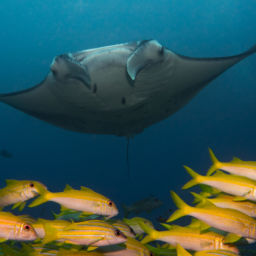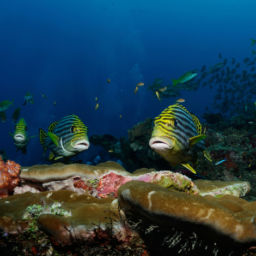Best known for its luxury resorts and romantic over-water bungalows, the Maldives is also one of the world’s greatest diving destinations. These Indian Ocean atolls are surrounded by deep water and attract large numbers of pelagic creatures. Some highlights include whale sharks, turtles, sharks, dolphins, the largest aggregations of reef mantas in the world and 21 species of cetaceans. The country is known not only for diving, but also for luxury accommodation. It is possible, however, to dive the Maldives on a budget — here’s how.
Live local
Since a 2009 regulation change allowing tourists to stay on ‘local islands,’ guesthouses have been popping up all over the archipelago. More recently, there has also been a boom in local dive shops partnering with guesthouses to provide a cheaper alternative to the international resort chains. Here are a few examples, from north to south.
Note that living local means you must abide by local Maldivian law. Alcohol is strictly prohibited (you may have your duty-free confiscated on arrival). Men and women should dress conservatively when not on the beach.
Choose a liveaboard
Liveaboards are cheaper than you may imagine as well, especially if you watch for sales, both early-bird offers and last-minute specials. Here are a few ideas.
The brand-new Emperor Explorer is the Emperor Fleet’s new flagship, and it’s a beauty. The Explorer has a choice of two itineraries, The ‘Best of the Maldives’ (central atolls), and (in February) ‘Deep South & Southern Sharks.’ Seven-night itineraries start at around US $1,900 per person when the boat launches in August 2020.
Another reasonably-priced liveaboard, the MV Sheena covers the central atolls, with a few special trips throughout the year including one for families or beginners. Seven-night itineraries start at US $2,030.
Getting there
The growth of budget airlines has made the Maldives far more accessible for budget-conscious travelers. From major hubs such as Singapore and Kuala Lumpur, budget carriers including SCOOT and Air Asia are pushing the prices down across the board.
When to dive the Maldives
You can dive the Maldives year-round with guaranteed pelagic action, however two monsoon seasons dictate the diving conditions.
The northeast monsoon runs from December to May, bringing calm seas and clear water with 65 to 130-foot visibility (20 to 40 m) to the eastern atolls, but often stirs up conditions on the western atolls, where visibility drops to 26 to 50 feet (8 to 15 m) visibility. This is generally the most popular time for diving.
From June to November the southwest monsoon brings clear water to the western atolls, but also rougher seas across the island nation. Fewer liveaboard options are available at this time of the year, and some resorts will offer low-season discounts.
Water temperatures in the Maldives vary from 79 to 84 F (26 to 29 C), so a 3 mm full wetsuit is ideal.
Where to see big stuff
If it’s the mantas of Hanifaru Bay you want to see, they descend in the hundreds on Baa Atoll between June and November. You are more likely to see them elsewhere in the Maldives during this time of year as well.
The whale sharks of South Ari Atoll are there year-round. The whale-shark dive site here, which runs along the back of Dhigurah Island, has been identified as a secondary nursery, populated mainly by juvenile males. Locally-based researchers have identified all of them. Elsewhere in the archipelago, again, you’re more likely to see them between June to November.
Several species of sharks and rays call the Maldives home, including large schools of nurse sharks (the world’s largest aggregation) and eagle rays, with hot spots for shark action in the central and south atolls, including Vaavu. The only difference between rainy and dry season is a slight difference in visibility. Diving the Maldives on a budget is not only doable, but quite manageable if you know when and wh









